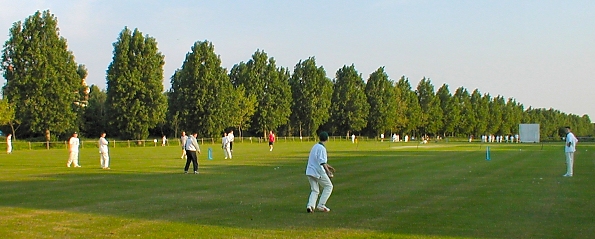|
bacon-and-egg tie
A nickname for the
assertive red-and-yellow-striped tie worn by members of the Marylebone Cricket Club.
A broad-minded understanding
of why players might be tempted by the riches on offer did not seem to be high on the agenda of the bacon-and-egg-tie brigade
at Lord's; the first loyalty of cricketers was to their country.
The Independent on Sunday (13 July 2008)
Harrow drive
A cricket term that
seems originally, in the mid-19th century, to have been applied to an off-drive, presumably thought of as a specialism of
Harrovian batsmen. Well before the close of the century, however, those inclined to poke fun at the school’s pretensions
were using it to denote a botched or edged drive, and by the middle of the 20th century it was firmly attached to a stroke
that sends the ball accidentally off the inside edge of the bat past the leg stump.

|
| Woodford Green is claimed to have the oldest village cricket field still in use |
Lord’s Taverners
An association
of cricket-lovers founded in 1950 by Martin Boddey. It stages matches and other events to raise funds for charity. There is
a large ‘stage-and-screen’ element in its membership and its patron is the Duke of Edinburgh. Its name commemorates
the Tavern at Lord’s cricket ground, a hostelry to the right of the pavilion which was demolished in the early 1960s
(the Tavern Stand now occupies its site).
The Oval or Kennington
Oval
A cricket ground in kennington that takes its name from a street layout devised in 1790, although
the plan was never fully realized. It has a spectator capacity of over 23,000. In 1844 the Montpelier Cricket Club leased
10 acres (4 hectares) of the Oval’s market gardens after it had been ejected from its ground at Walworth. Cabbage patches
were buried under turf brought from Tooting Common and an embankment was raised using soil excavated during the enclosure
of the River Effra at Vauxhall Creek. Shortly after the ground opened a group of aficionados founded Surrey County Cricket
Club at a meeting in the neighbouring Horns Tavern; Surrey played its first county cricket match against Kent in 1846. The
first test match in England was staged here, in 1880 (between England and Australia – England won by five wickets).
It was after Australia’s victory at the Oval in 1882 that the ashes came into being. In the past the Oval has been associated
with various other activities, sporting and otherwise. Most FA Cup finals between 1872 and 1892 were played here, as were
England’s first rugby union matches against Scotland and Wales. During the Second World War it was a prisoner-of-war
camp and in 1971 it hosted its first pop concert but nowadays the playing area is reserved largely for cricket. At 558 feet
(170m) by 492 feet (150m) it has the largest area of any cricket ground and the gasholders on its north-eastern side have
become an Oval icon. It is presently known as the Brit Oval, owing to the sponsorship of a bishopsgate-based insurance company.
The Oval has given its name to cricket grounds in several former British colonies, including Sri Lanka and Barbados.
|

